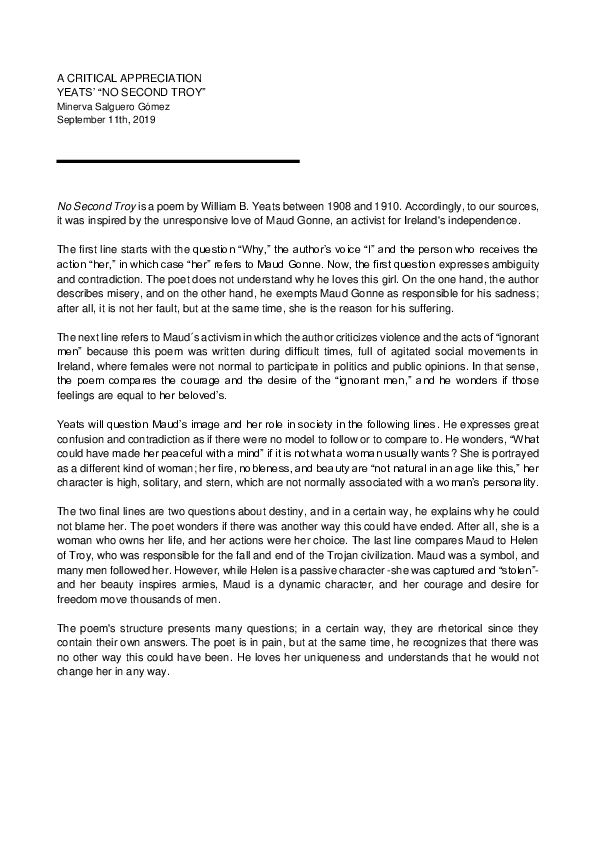Academia.edu no longer supports Internet Explorer.
To browse Academia.edu and the wider internet faster and more securely, please take a few seconds to upgrade your browser.
A CRITICAL APPRECIATION YEATS' "NO SECOND TROY"
A CRITICAL APPRECIATION YEATS' "NO SECOND TROY"
2019, A CRITICAL APPRECIATION YEATS' "NO SECOND TROY"
No Second Troy is a poem by William B. Yeats between 1908 and 1910. Accordingly, to our sources, it was inspired by the unresponsive love of Maud Gonne, an activist for Ireland's independence.
Related Papers
The Yeats Journal of Korea
Something that a boy piped in Thessaly”: Yeats and the 1916 Rising in Context2016 •
The paper intends to analyze the importance of Irish mythological heroes in the poetry of W.B.Yeats in the context of Irish nationalism. The Irish Literary Revival had its ramifications, as is quite evident from the inspiration which rebels got from the Irish legendary heroes like Finn, Oisin and Cuchulain in fighting against all odds for the sake of Irish soil. Yeats being a serious artist and staunch patriot was well aware about the importance of myths, folklore and legends in shaping the psyche of the common masses. The paper will try to highlight the significance of these mythological heroes as a source of inspiration for the Irish nationalists. Taking 'time and space' limitations into consideration, the main focus will be on Irish legendary heroes like Cuchulain and Oisin.
“ ‘O when may it suffice?’: W. B. Yeats, the Easter Rising, and the Poetry of Difficult Times.” Reading Ireland 2.1 (September 2016): 22-32. For the text of my epipgraph, see the youtube link on this page.
Marquette University, Milwaukee WI Conference, 2002
George Yeats's Creative Contribution to W.B. Yeat's Poetry2002 •
RELATED PAPERS
Arusha Working Papers in African Linguistics
The Emergence of Lexical Applicatives in Iraqw2022 •
Гласник Српског археолошког друштва 38 (2022)
A case of skeletal tuberculosis in a man from the site of Đurine ćelije on Rudnik2022 •
2015 •
American Journal of Physiology-Heart and Circulatory Physiology
The mitochondrial permeability transition pore as a target of cardioprotective signaling2007 •
Clinical Transplantation
Fresh tissue parathyroid allotransplantation with short-term immunosuppression: 1-year follow-up2017 •
Journal of Interferon & Cytokine Research
Anti-CD138-Targeted Interferon Is a Potent Therapeutic Against Multiple Myeloma2015 •
2010 •
Annals of Spiru Haret University Economic Series
Protocol for a Scoping Review on the Conceptualization of Competitive Intelligence in Entrepreneurship Literature2021 •
Binus Business Review
Pengaruh Kepuasan Kerja terhadap Loyalitas Staf Reception pada Hotel X di Madiun Jawa Timur2012 •
International journal of environmental research and public health
Air Pollution and Dispensed Medications for Asthma, and Possible Effect Modifiers Related to Mental Health and Socio-Economy: A Longitudinal Cohort Study of Swedish Children and Adolescents2017 •

 Minerva Salguero Gómez
Minerva Salguero Gómez